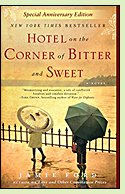Hotel on the Corner of Bitter and Sweet
by Jamie Ford
Reviewed by Margaret Tomlinson

Hotel on the Corner
of Bitter and Sweet
moves between two time periods in Seattle. In the 1980s, in the year after his
wife's death, Henry Lee is haunted by the memory of his first love, lost to him
during the war years of the 1940s. Renovation work at the old Panama Hotel, abandoned
for years, has brought to light a cache of photograph albums and household
goods. They were stored in the basement forty years earlier by Japanese-American
families forced to abandon their homes and relocate to internment camps in the
months after the Pearl Harbor attack.
Henry,
twelve years old in 1942, is a first-generation Chinese-American whose immigrant
father nurses a hatred of the Japanese because of Japan's war of aggression
in China. Henry's father feels only satisfaction when he sees Japanese-Americans persecuted. But
Henry is a scholarship student at a prestigious school where he is one of only
two children of Asian descent. He and Keiko, a second-generation Japanese-American,
work together in the cafeteria and become friends. It only adds to his mixed
feelings that his father makes him wear a button on his jacket, "I am
Chinese," because Seattle's white population can't tell the difference
between Chinese and Japanese faces.
The story of how Henry and Keiko become friends and then sweethearts, how they lose each other, and how Henry meets his wife unfolds slowly as the novel moves back and forth between the 1980s and 1940s. It's never confusing or hard to follow. Its crystal clarity about the characters' emotions and motivations, even when Henry himself feels confused or uncertain, will be appreciated by readers who enjoy popular novels. Readers who prefer literary fare with more complex characters and moral ambiguity may find Hotel on the Corner of Bitter and Sweet a bit bland, though it has enough sweetness and mystery to carry any reader through to the end. (2009, 309 pages)
More about Hotel on the Corner of Bitter and Sweet at Powell's Books or The Book DepositoryOther novels about internment camps:
Snow Falling on Cedars by David Guterson (1994), about a man whose love for a Japanese-American girl sent to a relocation camp during World War II is reawakened after the war when her innocent husband is tried for murder. More info.
When the Emperor Was Divine by Julie Otsuka (2003), about a Japanese-American family's experiences after Pearl Harbor, when the mother and children are interned in Utah while the father is sent to a camp in New Mexico. More info
The Japanese Lover by Isabel Allende (2015), , about a young Polish woman sent to live with relatives in San Francisco in 1939, where she falls in love with the family's Japanese gardener. More info
Nonfiction about WWII internment camps:
Un-American: The Incarceration of Japanese Americans During World War II: Images by Dorothea Lange, Ansel Adams and Other Government Photographers by John Varriano (2016). More info
Infamy: The Shocking Story of the Japanese-American Internment in World War II, by Richard Reeves (2015). More info
Midnight in Broad Daylight: A Japanese American Family Caught Between Two Worlds by Pamela Rotner Sakamoto (2016). More info
Online:
Japanese Relocation During World War II at the US National Archives website
Back to WWII America, Home Front
Back to Directory of Book Reviews